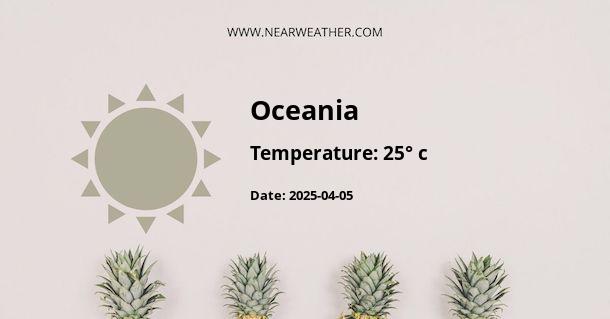Oceania: Climate and Weather Overview
Oceania, a region comprising Australasia, Melanesia, Micronesia, and Polynesia, is known for its incredibly diverse climate and weather patterns. From the tropical rainforests of Papua New Guinea to the arid deserts of Australia, Oceania offers a wide range of climates that cater to various preferences and interests.
Australia
Australia, the largest country in Oceania, experiences a plethora of climates due to its sheer size. In the northern regions, the climate ranges from tropical in the north to temperate in the south. The central part of the country is dominated by arid and semi-arid conditions, with vast deserts such as the Simpson Desert and the Great Victoria Desert.
Climate and Weather by Region
| Region | Climate | Weather |
|---|---|---|
| Northern Australia | Tropical | High humidity, monsoonal rains in summer |
| Southeast Australia | Temperate | Four distinct seasons, mild to warm temperatures |
| Central Australia | Arid and Semi-arid | Hot and dry, minimal rainfall |
Australia's diverse climate also includes alpine regions in the southeast, where snowfall is common during the winter months. The coastal areas generally experience milder temperatures due to the moderating effect of the surrounding oceans.
New Zealand
New Zealand, located southeast of Australia, has a maritime climate influenced by the surrounding ocean. The North Island tends to be warmer and wetter, while the South Island experiences cooler temperatures, especially in the southern regions where alpine conditions prevail.
Main Cities Weather Overview
| City | Average Temperature (°C) | Annual Precipitation (mm) |
|---|---|---|
| Auckland | 15.2 | 1240 |
| Wellington | 12.6 | 1240 |
| Christchurch | 11.3 | 648 |
The precipitation throughout New Zealand is relatively high, contributing to its lush and vibrant landscapes. The country is also prone to occasional weather extremes such as heavy rainfall and strong winds, particularly in the western regions due to the influence of the Tasman Sea.
Polynesia, Melanesia, and Micronesia
These island regions within Oceania experience tropical climates characterized by consistently warm temperatures and high humidity. The weather patterns in these areas are influenced by the trade winds and the presence of the Intertropical Convergence Zone (ITCZ), resulting in a distinct wet and dry season for many islands.
Key Climate and Weather Features
- High average temperatures ranging from 25°C to 28°C
- Pronounced wet and dry seasons
- Cyclone risk during the wet season
Due to their proximity to the equator, these island nations receive abundant sunshine throughout the year, making them desirable destinations for beachgoers and water sports enthusiasts.
Conclusion
Oceania's climate and weather showcase the incredible diversity and natural beauty of the region. From the harsh deserts of Australia to the lush rainforests of Papua New Guinea and the stunning coastlines of the South Pacific islands, Oceania offers a remarkable range of climates and weather experiences for travelers and residents alike.
Understanding the intricacies of Oceania's climate and weather not only enhances our appreciation of the region's environmental dynamics but also contributes to better preparation and enjoyment of all that Oceania has to offer.
A - Oceania's Latitude is -18.312811 & Longitude is 138.515625.
A - Weather in Oceania is 31° today.
A - Climate Conditions in Oceania shows overcast clouds today.
A - Humidity in Oceania is 19% today.
A - Wind speed in Oceania is 11.34 km/h, flowing at 160° wind direction. today.
